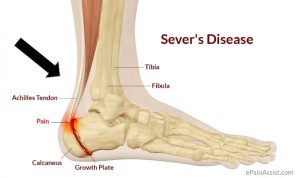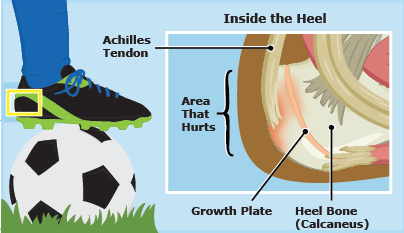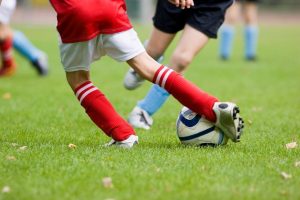Sever’s Disease
What is Sever’s Disease?
Sever’s disease (calcaneal apophysitis) is a common cause of heel pain in children between the age of 7 to 14. It is predominantly present in kids who are active and play sports such as soccer, rugby league, AFL, netball, basketball, rugby and hockey. Boys are more likely to development this condition than girls and it usually develops just before puberty.
Causes of Sever’s Disease
The cause of Sever’s is uncertain however much research and evidence has suggested that constant physical activity is one of the biggest causes of symptoms.
The Achilles tendon joins into the heel at the back of the foot and the arch ligament attaches underneath the heel at the bottom of the foot. Between the ages of 7-14 the heel bone has not completely fused and during a growth spurt the bones grow faster than the muscles causing the Achilles tendon and calf muscle to tighten up. During this growth period the heel is susceptible to injury as it is a weak spot as it results in a traction type injury on this weak spot, resulting in inflammation and pain.
Symptoms of Sever’s Disease includes:
- Pain at the heel or around the Achilles tendon
- Heel pain during physical exercise such as running or jumping
- Aggravation of pain after exercise
- Swelling or tenderness on the heel that is sore to touch
- Calf muscle stiffness first thing in the morning and a limping gait
- A tendency to tiptoe
Incidence Rates
Sever’s disease is the most common cause of heel pain in children and adolescents, usually occurring between 7 and 14 years.

Who is at risk of developing it? What are the risk factors?
Apart from age, other factors that may contribute to developing Sever’s disease include:
 Physical activity – any form of exercise that is weight bearing through the legs or stresses the soft tissue can exacerbate the pain of the disease.
Physical activity – any form of exercise that is weight bearing through the legs or stresses the soft tissue can exacerbate the pain of the disease.- Wearing poor, unsupportive shoes for exercise.
- External factors – for example, running on hard surfaces or wearing inappropriate shoes during sport and activities
- Overuse injury – very active children may repeatedly but subtly injure the bones, muscles and tendons of their feet and ankles.
What are treatments used to manage Sever’s disease?
Treatment depends of the severity of the condition and it is advised to consult a podiatrist who will diagnose and treat accordingly. Some treatment options include:
- Relative rest and modified activity – one of our qualified podiatrists can help work out what and how much activity to undertake safely without affecting the growth plate long term.
- Cold packs – apply ice or cold packs to the back of the heels for around 20 minutes after any physical activity, including walking.
- Correct footwear – wearing the correct shoe for your foot type and activity type is imperative to managing Sever’s pain.
- Heel raises – small heel inserts worn inside the shoes can take some of the traction pressure off the Achilles tendon. This may only be required in the short term.
- Medication – anti-inflammatory medication may help in extreme cases, but should always be combined with other treatment and following consultation with your doctor. Anti-inflammatory creams are also an effective management tool.
- Strapping and orthotic therapy – pending your foot function and structure, strapping and orthotics may be useful to unload pressure on the growth plate and allow normal sport and activity.
